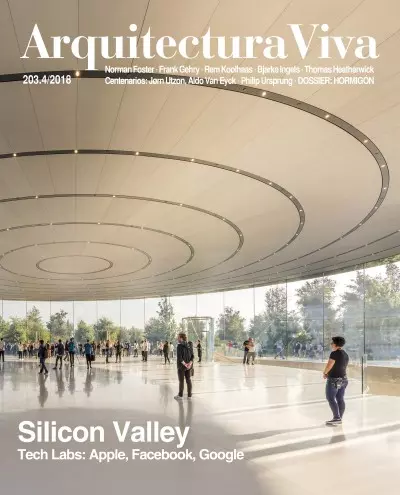


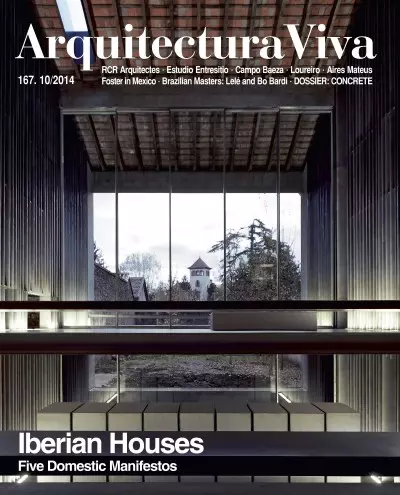
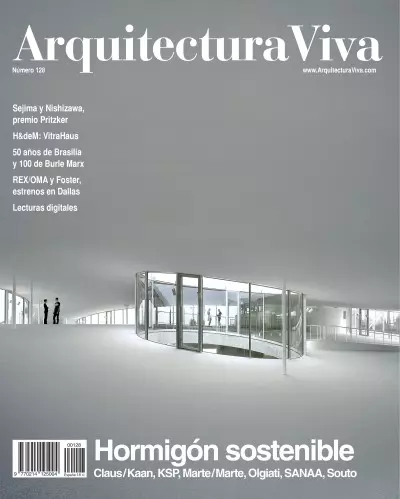
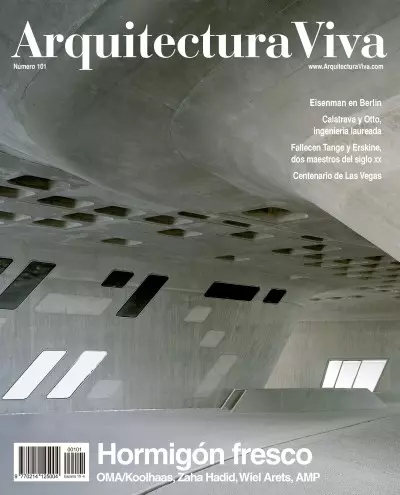
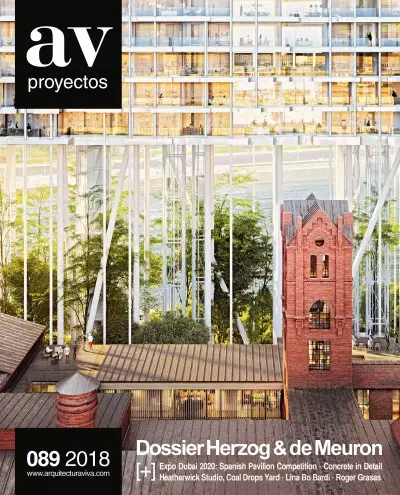
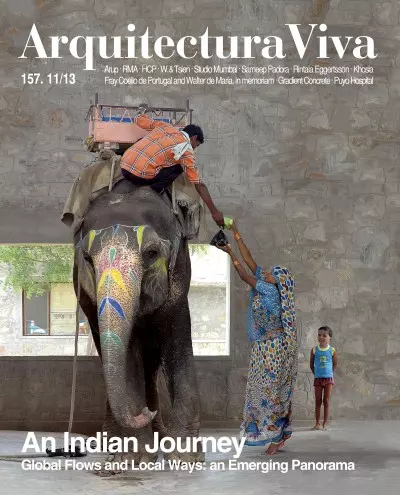
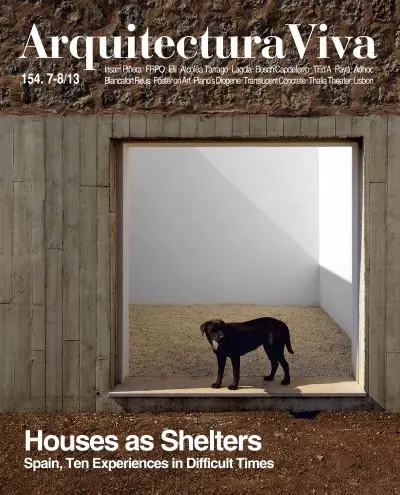
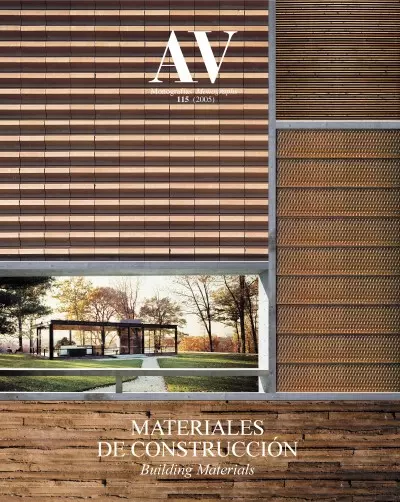
Three turrets built with reinforced concrete rise as sculptural skylights on top of the roof of an old merchandise warehouse transformed into a hall for showcasing art. The base of the lanterns is used as a way to separate the spaces of the exhibitio
A block which contains open-plan levels for offices and retail premises simultaneously provides a covered nexus between a railway platform and a bus shelter. With one of its bays jutting out in a cantilever, the monolithic ensemble of supports and sl
This house is many houses in one: one looks towards a circular interior patio, the other opens up to different views along the outer perimeter; one is at ground level, and the other is a green roof, 360º+360º. An extroverted house during the day, loo
The new Harbormaster’s Building in Ayamonte, located at the marina, stands out on account of its bold materiality and angular geometry, evoking old coastal defensive constructions. It is an architecture of strong presence, rooted in the landscape by
After more than two decades of abandonment, the Hyparschale in Magdeburg has been renovated and transformed into a multifunctional space, following plans drawn up by gmp Architekten von Gerkan, Marg und Partner. Originally designed in 1969 by the eng
Rising almost 30 meters, Tor Alva is the tallest 3D-printed tower in the world. Built by Nova Fundaziun Origen with ETH Zurich, it aimed to revitalize Mulegns (Switzerland), a small Alpine village with only eleven inhabitants at present. Tor Alva (Wh
An ideas competition was held to build a virtual production center in what was a weapons factory in A Coruña. It is now the Cidade das TIC, a facility for developing information and communication technologies. The winning design – by the firm Díaz y
Instead of reconstructing the fallen roof, the project of converting an animal shed into a studio inserts a free-standing structure so as not to overburden the fragile existing walls. Unshackled of loads to bear, the brickwork and a gable-end kept up
Four concrete volumes with a circular floor plan – based on the silos where the Barcelona office is located – are organized symmetrically around a square-shaped core. The exaggerated proportion and the color palette of the interior create an almost t
Built high on a hill near the town of Santa Bárbara de Nexe, this concrete house fuses with nature while evoking the image of an old ruin. To make the most of views, the main livable zones are placed in the upper level, a 385-square-meter space. The
How do we want to work tomorrow? That is the question that EM2N set out to answer in designing the building located at Binzstrasse in Zurich. From the start of the project it was clear that the Swiss practice would itself take part of the rental spac
The facilities of the oldest Chinese distillery still in operation are surrounded by new production buildings with pitched roofs, where traditional fermenting and liquor-making practices are perpetuated. A courtyard connects the various volumes, whos
A circular enclosure, semi-buried in the terrain, fuses symbolically with the landscape of Todos Santos, in the South Baja California Desert. This discreet project, commissioned by Paradero Hotels, harbors a 185-square-meter non-religious ceremony sp
Located in Lanheses, an industrial area in the Portuguese municipality of Viana do Castelo, BW II is a building for BorgWarner, an American group of manufacturers of electric motors and components for both light and heavy and both hybrid and electric
The Rruga Adem Jashari mixed-use development presents three russet-hued towers and a white stepped pyramid. Located on a strategic site in the Albanian capital, on the boundary between the urban fabric and an adjacent park, the pigmented concrete co
This mosque, built in concrete pigmented with reddish tones, is located in a fast-growing industrial area of Ashulia, on the outskirts of Dhaka, the capital of Bangladesh. A factory owner decided to build it for his employees and in memory of his dec
Covering 24 hectares, The Biomist in the city of Genk, in the Belgian province of Limburg, is a complex devoted to biocultural diversity that includes the studio of artist Koen Vanmechelen and the Cosmopolitan Cultural Park, where the LlabOvo pavilio
In 2012, the cities of Basel (Switzerland), Huningue (France), and Weil-am-Rhein (Germany) signed an urbanistic agreement to create a cross-border district. Inserted in the first phase of the neighborhood’s development is the Link Building. Containin
The spatial configuration of these facilities seeks to create a ‘city’ for abandoned or stray dogs and cats. Run by Ahgtinsa, this new municipal service in Granada offers protection and accommodation for animals to be subsequently given up for adopti
The King Abdullah Financial District (KAFD), designed by Zaha Hadid Architects, is a centerpiece of Riyadh’s ambitious metropolitan railway system, which inaugurates its first lines on 1 December 2024. Able to accommodate 3.6 million commuters daily,
The higher studies of architecture, landscape design, and planning are now concentrated in a new urban campus: L’Institut Méditerranéen de la Ville et des Territoires. Although the concrete structure of light color tones has the effect of unifying th
The design for this 50-meter-tall cultural hub with a cone shape took into account how the sun changes course during the year. Located in China’s northeastern city of Yantai, the Sun Tower was conceived as a giant sundial composed of two connected la
Although Portugal is mainly a maritime country, its inland is traversed by mighty mountains, largely unknown of but whose beauty will not be unfamiliar to those who have read authors like Eça de Queirós or Miguel Torga. In one of those ranges, on a m
British schools are crumbling due to an aerated material that was popular after World War II. The issue centers around “reinforced autoclaved aerated concrete,” a material known more widely as RAAC, which can become dangerous if exposed to water. The
New techniques and novel ingredients can greatly reduce the immense carbon emissions from cement and concrete production. We make more concrete than we do any other material on Earth. Cement is one of the most energy-intensive products on the planet.
The concrete used was self-healing and anachronistically green The romans were master builders. Many of their works, from the Pantheon (pictured above) and the Colosseum in Rome itself, to the Pont du Gard in southern Gaul and the equally impressive
They offer ways to produce cement without releasing carbon dioxide. Concrete is one of the world’s most important materials. But making the cement that binds it generates about 8% of anthropogenic carbon-dioxide emissions. This is not just because of
It is a big source of emissions, but might one day be the reverse. The romans perfected concrete, and their legacy still stands in the form of the magnificent roof of the Pantheon, the world’s largest unreinforced concrete dome. Since it was complete
But for now, a square meter of the building material holds roughly the energy of two AA batteries. Concrete, after water, is the world's most used material. Because it already surrounds us in the built environment, researchers have been exploring the
The residential building that the Madrid-based trio Arenas Basabe Palacios has raised in the Spanish capital’s Salamanca neighborhood has two different faces: towards the street it presents a classical tripartite composition soberly regulated by pref
Brutalism with a friendly countenance: this is how one might venture to describe the architecture that Grafton Architects – Yvonne Farrell and Shelley McNamara – have been carrying out for the past twenty years in Ireland, Europe, and America, from t
Students of the Master of Advanced Studies in Digital Fabrication and Architecture program at Eidgenössische Technische Hochschule (ETH) Zürich have built ‘Concrete Choreoraphy,’ an installation of columns made of special concrete with the assistanc
From ancient civilisations to the present day, columns have served as elements of architecture particularly tied to the harmony, balance and proportion of architectural orders – so much so that they have come to be recognised as works of art in their
The rise of a renewed interest in Brutalism seventy years after its birth is reflected both in the growing defense of heritage ascribed to this architectural current – arising from the Modern Movement with Le Corbusier and the use of béton brut (raw
Libraries have been one of the symbols of bourgeois society. Originally confined to monasterios and palaces, distant havens of elitist knowledge, libraries eventually became quintessential public spaces in the capitalist and increasingly democratic c
After a generation in the doghouse, concrete is more fashionable than ever. So why don’t we take better care of our brutalist architecture? Concrete is everywhere. It is not only under our feet and above our heads, forming the background infrastructu
Empty the building, leave its sculptural brick enclosure exactly the way it is, and implant in it a massive heart of concrete. This was the strategy followed by Tadao Ando when he transformed an old residential block in the city of Chicago into the n
It has been announced by the College of Architecture of the Illinois Institute of Technology (IIT) in Chicago that the winner of the Mies Crown Hall Americas Prize (MCHAP) – awarded every two years to the finest works of architecture carried out in t
Though partly discredited and forgotten, Rudolphs buildings continue to be considered a powerful body of work in American architecture.
After a protracted process, a period of eight years, that has not been spared its dose of controversy (in 2015 it was announced that the building’s real cost would exceed the initially budgeted amount of 50 million euros by a good 70%), Scotland’s ow
Since early in the 20th century, when August Perret referred to it as “the stone that we craft,” reinforced concrete and the industry associated with it have evolved to the point that we can raise buildings entirely with this material. Perret – who w
The Irish firm of Yvonne Farrell and Shelley McNamara, operating since 1978 as Grafton Architects, has been much acclaimed for the Luigi Bocconi University in Milan, a half-buried civic box of concrete – completed in the year 2008 – that strikes an i
It was she herself, Mother Nature, who first fabricated concrete, and the Stone Age man was first to imitate it. Not in vain. In the beginning it was a material formed simply by mixing natural abiotic elements, small dry stones, conglomerate dust (p
Since its very beginnings, the concrete industry has always gone hand in hand with the production of chemical agents that have the potential to improve the properties of the material. At first, the focus of these chemical products was on reducing the
The most unique characteristic of this residential complex comprising twelve social housing units in La Alberca de la Záncara (Cuenca) is its low-cost – but very efficient – building system. These dwellings combine concrete blocks forming three-meter
Among the products of translucent concrete currently on the market, the Lucem Lichtbeton system, developed by the German firm of the same name, stands out for its technical caliber, and especially for its competitive selling price, which is not much

